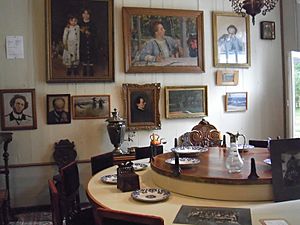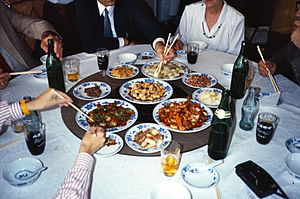Lazy Susan facts for kids
A Lazy Susan is a special rotating tray that sits on a table or counter. It helps people easily share food, especially in a group. These turntables are usually round and made from materials like glass, wood, or plastic. You often see them in Chinese restaurants, where they make it simple to pass around many dishes, like dim sum. Even though they are popular in China, the Lazy Susan was actually invented in the Western world. In Chinese, they are called cānzhuō zhuànpán, which means "dinner-table turntables."
Contents
The Story Behind the Lazy Susan
The exact story of how the Lazy Susan got its name is a bit of a mystery! Some old tales say it was an American invention. One popular story suggests that Thomas Jefferson invented a similar device called a "dumbwaiter" for his daughter, Susan. However, the name "Lazy Susan" itself appeared much later.
Early Rotating Tables
Before it was called a Lazy Susan, similar rotating tables were known as "dumbwaiters." In the 1700s, people used these silent machines to serve food without needing many servants. These early devices were often wheeled serving trays. At some point, the name "dumbwaiter" also started being used for rotating trays.
The Name "Lazy Susan" Appears
The term "Lazy Susan" first appeared in print in 1903 in the Boston Journal. It described a device made by a Scottish carpenter named John B. Laurie. He created his "Lazy Susan" to help solve the problem of needing servants to pass food. The article said, "She can be seen, but not heard... she simply minds her business and carries out your orders in a jiffy."
Growing Popularity
By 1917, a store called Ovington's advertised a "Revolving Server or Lazy Susan" in Vanity Fair magazine. The famous car maker Henry Ford even used a huge one on his camping trips in the 1920s to make serving food easier for his guests. In 1933, the term "Lazy Susan" was officially added to Webster's Dictionary.
A German Connection?
Interestingly, in 1916, a magazine called American Cookery said the device was a German invention. They described a "Lazy Susan" used in Germany that had seven dishes and turned easily. This shows that similar rotating serving trays were used in different places.

Modern Comeback
After the 1950s, the Lazy Susan became very popular again. An engineer named George Hall helped redesign and reintroduce them. They became a common sight in Chinese restaurants and homes around the world. This was partly because fewer people worked as domestic servants after World War II, and families needed easier ways to serve meals.
Other Uses for Turntables
Sometimes, the term "Lazy Susan" is also used for other types of turntables. For example, artists use similar rotating platforms for pottery or sculpture. These help them turn their work easily while they are creating or repairing things.
See also
 In Spanish: Tabla giratoria para niños
In Spanish: Tabla giratoria para niños



